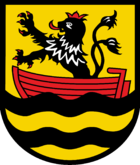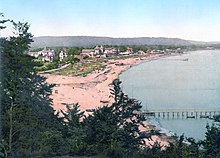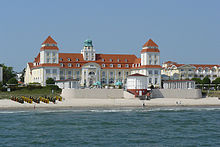Binz
| coat of arms | Germany map | |
|---|---|---|

|
Coordinates: 54 ° 24 ' N , 13 ° 37' E |
|
| Basic data | ||
| State : | Mecklenburg-Western Pomerania | |
| County : | Western Pomerania-Ruegen | |
| Height : | 3 m above sea level NHN | |
| Area : | 25.23 km 2 | |
| Residents: | 5393 (Dec. 31, 2019) | |
| Population density : | 214 inhabitants per km 2 | |
| Postal code : | 18609 | |
| Area code : | 038393 | |
| License plate : | VR, GMN, NVP, RDG, RÜG | |
| Community key : | 13 0 73 011 | |
| LOCODE : | DE BZR | |
| Address of the municipal administration: |
Jasmunder Strasse 11 18609 Binz |
|
| Website : | ||
| Mayor : | Karsten Schneider (Pro-Binz) | |
| Location of the municipality of Binz in the Vorpommern-Rügen district | ||
Binz is the largest seaside resort on the island of Rügen . The office free community is part of the Vorpommern-Rügen in Mecklenburg-Vorpommern . It bears the name Binz and the name Ostseebad preceded by the name. Binz forms a basic center for its surroundings .
The seaside resort is known as a holiday destination for its variety of culture and events, splendid spa architecture , the Granitz hunting lodge , the "Colossus of Prora ", the fine sandy beach and the surrounding nature, which is also documented and made tangible in the Rügen Natural Heritage Center .
geography
Geographical location
Binz is located on the east coast of the island of Rügen between the Prorer Wiek bay and the Schmachter See . The Schmale Heide , a headland that connects the motherland of Rügen with the Jasmund peninsula, extends north of Binz . To the east and south of the municipality the area is hilly, in the southeast in the Granitz heights are just over 100 m above sea level. Reached NHN .
Community structure
The municipality of Ostseebad Binz consists of the districts Binz, Jagdschloss Granitz and Prora .
Neighboring communities
Neighboring communities of Binz are (starting from the north) Sassnitz , Bergen , Zirkow , Lancken-Granitz and Sellin .
history
Fishing and farming village
1318 the place was first mentioned as "Byntze" in a tax collection of the county Streu. The core of the settlement was today's middle Bahnhofstrasse and Rabenstrasse, alongside the individual farmsteads Granitz-Hof and Aalbeck. The parish village and center of the parish was Zirkow .
A first hint of the later importance as a seaside resort emerged as early as 1830, when guests of Prince zu Putbus bathed at the mouth of the Ahlbeck (outflow of the Schmachter See). In 1835 a one-class school was established. Around 1850, farmers in Binz were allowed to buy the land that had been leased by Prince zu Putbus.
The place was part of the Principality of Rügen until 1326 and then the Duchy of Pomerania . With the Peace of Westphalia of 1648, Rügen and thus also the town of Binz became part of Swedish Pomerania . In 1815, Binz came to the Prussian province of Pomerania as part of New Western Pomerania . From 1818 Binz belonged to the local district of Rügen .
Development to the Baltic seaside resort
Bathing in the sea became fashionable around 1875. The first guests came to the small town of Binz, took a liking to it and recommended it to others. In the same year the first road connecting the village to the beach (Putbuser Straße) was built. Ten years later, Binz officially became a seaside resort , which resulted in a lot of construction going on: the beach promenade, the pier, the Kurhaus, a new network of paths and the small railroad connection. Around 1870 there were 80 bathers per year. In Binz and in other seaside resorts on the Baltic Sea coast, no large hotels were built at the end of the 19th century, but lodging houses in the villa style of the so-called resort architecture . They were given names shaped by the zeitgeist: nationalistic ones such as “Germania” or names of family members - often the first name of the builder's wife. The first hotel was built in 1876. In 1880 Wilhelm Klünder had the beach hotel built as the first hotel near the beach. In 1888 the public limited company Ostseebad Binz was founded, which opened the first Kurhaus Binz in 1890 and went bankrupt in 1891.
In 1892 Binz gained the status of an independent rural community. From 1896 ships of the Stettiner shipping company Braeunlich connected the places Stettin-Binz-Sassnitz with each other. A brisk construction activity followed. In 1893 the first Kurhaus and the Kaiserhof were built. In 1895 the Putbus-Binz small railroad was built and the beach promenade was built, and in 1898 the first post office was built (Kliesow House, Hauptstrasse). Separate women's and men's baths have been created on the beach. In 1902 a 600 meter long pier was built. Further infrastructural measures were the drinking water supply and sewerage (1903) and the construction of a power station (Jasmunder Straße).
Two setbacks were the destruction of the pier by a storm on New Year's Eve in 1905 and the fire at the Kurhaus in 1906. After the pier was rebuilt, a new Kurhaus was built in 1908. A family bathroom was also created. In 1912, part of the bridge collapsed, killing 16 people, including two children. As a result, the DLRG was founded in Leipzig in 1913 .
The Protestant church was inaugurated in 1913 and the new post office in Zeppelinstrasse was completed in 1928. Little by little, the bathing establishments built on the beach disappeared. The Herrenbad was demolished in 1922, and the last one was the family bath in 1932.
National Socialism
In 1937, extensive work began in Prora on the KdF seaside resort of Rügen, which was to be expanded to become the largest and most modern seaside resort in Europe. In the same year the Kurplatz was rebuilt. The Binz station building (now DB) was built in 1938, and the Lietzow – Binz railway line opened in 1939 .
The pier was destroyed again by ice in 1942. After the Second World War in 1945, hotels, pensions and villas housed displaced persons and resettlers.
GDR
In 1945 the district of Rügen and thus also Binz was incorporated into the state of Mecklenburg of the Soviet occupation zone and belonged there to the district of Rügen . With the GDR territorial reform in 1952, Binz became part of the newly created Putbus district , which was dissolved again in 1955. Since then, Binz has belonged to the Rügen district in the Rostock district .
1950 Binz Bad became the SDAG Wismut . The interrupted work on the buildings of the KdF -Bad continued after 1950 in order to create barracks for the People's Police , which were later used by the National People's Army .
In 1952 the Lietzow – Binz railway was put back into operation.
In 1953, the " Rose Action " also took place in Binz . Owners of hotels, guest houses and houses were arbitrarily criminalized, arrested and expropriated. In 1956, the FDGB took over the first holiday home in Binz with the Seeschloß . From 1972 onwards, further holiday homes were built for the FDGB (e.g. Haus Arkona, Haus Rügen, Haus Rugard). A residential area in prefabricated construction was created north of the previous place , which affects the established appearance of the place. The Ahlbeck, which carries the water from the Schmachter See into the Baltic Sea, was piped in the 1950s. The "mouth" of the pipe section is on Binzer Strand and is now provided with a sign. From 1970 to 1985, a large residential area west with 736 prefabricated apartments was built.
Time from 1990

In 1990 the Rügen district became part of the state of Mecklenburg-Western Pomerania. Since the district reform in 2011 , Binz has been in the Vorpommern-Rügen district .
With the social change in the GDR and the German reunification , there were also clear changes for Binz. Many of the old villas on the beach promenade and throughout the village have been returned to their previous owners. A wave of renovations, reconstructions and new buildings began. The former FDGB holiday homes have also been privatized and completely modernized. In addition, numerous new buildings were built, both on the periphery and in the center. The streets and sidewalks were extensively repaired and the beach promenade was extended towards the Prora. The Kurplatz received a new design.
In 1990 the tourist association Binz e. V. founded, in 1994 the new, 370 meter long pier was inaugurated, which replaces the bridge that was destroyed in 1942.
In 1998 the new municipal administration building was inaugurated on Jasmunder Strasse. The Haus des Gastes was opened in 2000 and the Kurpark Binz in 2002. In 2003 the promenade at Schmachter See and the Park of the Senses were opened. Since May 2007, the entire main street and the splendid turning area have shone in new splendor.
Population development
|
|
Status: December 31 of the respective year
politics
Community representation
The municipality of Ostseebad Binz has 17 members. The local elections on May 26, 2019 led to the following result:
| Party / group of voters | be right | Seats |
| Citizens for Binz | 26.6% | 5 |
| From the Middle | 25.6% | 4th |
| CDU | 16.8% | 3 |
| SPD | 15.2% | 3 |
| The left | 8.5% | 1 |
| AfD | 7.2% | 1 |
mayor
- until 2011: Horst Schaumann (independent)
- since 2011: Karsten Schneider (Pro-Binz)
Schneider was elected in the mayoral election on May 27, 2018 with 66.9% of the valid votes for a further term of seven years.
coat of arms
The coat of arms was adopted by the municipality on January 25, 1928 and registered under number 79 of the coat of arms of Mecklenburg-Western Pomerania.
Blazon : “In gold, two lowered black wavy bars; a red boat floats on the upper one, from which a red crowned, tongued and armored, double-tailed black lion grows. "
flag
The flag is made of yellow cloth, which is covered in the middle with the figures of the municipal coat of arms. The figures of the coat of arms occupy seven ninths of the flag height and half the flag length. The length of the flag is related to the height like 5 to 3.
Partnerships
The municipality of Binz maintains partnerships with Białogard in Poland and Cuxhaven in Germany.
Sights and culture
Buildings
- Granitz Hunting Lodge from 1846 and Granitzhaus from 1901
- Resort architecture in the whole place
- Neo-Gothic Protestant village church in Binz from 1913
- Stella Maris Catholic Church
- Museum Ostseebad Binz, Bahnhofstrasse 54
- Promenade
- Kurhaus Binz from 1908
- Binz pier from 1994 with a length of 370 meters
- Rescue station by Ulrich Müther , built in 1968, used today by the Binz registry office
- Promenade on Schmachter See , redesigned in 2003
- Kurpark Park of the Senses on Schmachter See
Prora
- Former KdF and later Prora barracks , started in 1935/1939 according to plans by Clemens Klotz , completed in 1950/56 as a major barracks building, five kilometers north of Binz, was never completely completed. It is considered to be the longest building in the world.
- Rügen Natural Heritage Center with the “Adlerhorst” observation tower, which offers a panoramic view of Rügen at a height of 82 m
Beach
The fine sandy Binz beach is around five kilometers long and up to 50 meters wide. The beach promenade with restaurants and hotels runs parallel to the beach. The beach turns south into a narrower and somewhat stony natural beach.
Regular events
- Swimming pool run (running competition)
- Beachcup (state championship Mecklenburg-Western Pomerania in beach volleyball)
- Blue Wave Festival, open air jazz music
- Binz Castle Festival at the Granitz Hunting Lodge with a medieval market
- Culture summer
- Open senior chess championship
- Rügenclassics (oldtimer rally)
- Rügen round (cycling marathon)
- Sand Sculpture Festival
- Traditional bathing
- Hiking spring
- Wine festival
- Seaside Architecture Week
- Christmas Market
Economy and Infrastructure
Companies
The economy of Binz is primarily geared towards tourism. There are numerous hotels, inns and restaurants in the village.
traffic
Binz is located on the L 29 national road between Sassnitz and Putbus .
The Ostseebad Binz train station in the center of the city is the end of the Lietzow – Ostseebad Binz line , a branch of the Stralsund – Sassnitz line ; it is the terminus of ICE and InterCity trains operated by Deutsche Bahn . Regional trains of the Regional Express line RE9 to Stralsund run hourly with further stops in Prora and Prora-Ost .
A second station, Binz LB (LB = Landesbahn), is located in the west of the city on the Rügen small train ("Rasender Roland") from Putbus to Göhren (Rügen) . It continues south via Sellin and Baabe .
In local transport, Binz is served by the Vorpommern-Rügen (VVR) bus routes . B. connected to Sassnitz , Bergen and Göhren. All year round, the buses run here at least every hour on the routes Königsstuhl – Sassnitz – Binz – Göhren – Klein Zicker and Sassnitz – Binz – Bergen. In the summer half-year, the buses in the direction of Göhren run every 15 minutes in the morning and in the afternoon and until midnight in the evening. At the DB station in Binz, the bus routes are linked to rail traffic.
The so-called Binzer Bäderbahn, which can be used free of charge with the spa card, opens up the town as a ring line.
The community is connected to the Baltic Sea Cycle Route (EV10) , which not only leads to Stralsund, but also as a European EuroVelo route around the entire Baltic Sea.
education
Binz has a primary school for grades 1–4 and the Ostseebad Binz regional school for grades 5–10, an all-day school ; there are also two daycare centers. Binz also has a small library .
Personalities
Sons and daughters of the church
- Franziska Dassow (around 1870 – after 1902), theater actress
- Adalbert Bela Kaba-Klein (1895–1962), investor in the Binzer Kurhaus (with Abraham Lemo, Armin and Eugen Reichard), stumbling block in front of the Kurhaus
- Ulrich Müther (1934–2007), civil engineer
- Sylvia Zacharias (* 1944), journalist
- Monika Schaal (* 1945), politician (SPD)
- Gudrun Schnirch (* 1945), politician (CDU)
- Peter-Michael Diestel (* 1952), politician (DSU, CDU), born in Prora
- Gesine Skrzepski (* 1955), politician (CDU)
People related to the place
- Otto Spalding (1863–1945), architect of the Kurhaus Binz
- Wolfgang Schnur (1944–2016), politician ( DA ), practiced as a lawyer in Binz between 1973 and 1978.
- Thomas Wilhelm (* 1984), athlete, grew up in Binz
Web links
Individual evidence
- ↑ Statistisches Amt MV - population status of the districts, offices and municipalities 2019 (XLS file) (official population figures in the update of the 2011 census) ( help ).
- ↑ Regional Spatial Development Program Vorpommern (RREP) 2010 ( Memento from September 24, 2015 in the Internet Archive ) - central-local structure with upper, middle and basic centers, accessed on July 12, 2015
- ↑ Main statute of the municipality of Ostseebad Binz, § 13
- ↑ German Life Saving Society e. V.
- ↑ Population development of the districts and municipalities in Mecklenburg-Western Pomerania (Statistical Report AI of the Statistical Office Mecklenburg-Western Pomerania)
- ^ Result of the local election on May 26, 2019
- ↑ Main statute of the municipality of Ostseebad Binz, § 7
- ^ Result of the mayoral election on May 27, 2018
- ↑ Cf. Matthias Ludwig: Leading article. Müthers Futurism, in: moderneREGIONAL 16, 3 .
- ^ Municipality of Ostseebad Binz: Blue-Wave-Festival of Jazz
- ↑ Tournament website of the State Chess Association Mecklenburg-Western Pomerania accessed on November 30, 2018 and photos
- ↑ Event highlights in the Baltic Sea resort of Binz ( Memento from June 13, 2017 in the Internet Archive ), official website
- ↑ Tourismusverband Mecklenburg-Vorpommern e. V .: Baltic Sea Cycle Route . In: Tourismusverband Mecklenburg-Vorpommern e. V. ( auf-nach-mv.de [accessed on May 11, 2017]).
- ↑ translator2: EuroVelo 10 - EuroVelo. Retrieved May 11, 2017 .
- ↑ Schools and daycare centers on the Ostseebad Binz website














